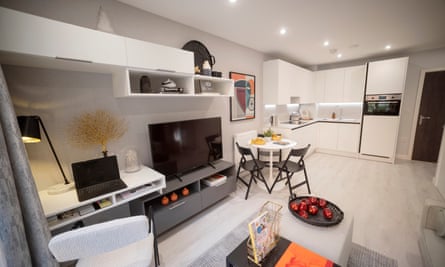For Rioch Fitzpatrick, a 39-year-old dubbing mixer for television, home is a tiny studio flat smaller than a standard Premier Inn hotel bedroom. At just 19 sq metres (204 sq ft), his north London “microflat” has a shower and lavatory separated from the main room by a partition, without even a separate wash basin.
“It’s probably a bit odd, people coming in and seeing your bed in the kitchen, but I’ve just got used to it,” he says. “My neighbours live in a flat similar to mine – a couple with a two-year-old kid. That must be really tough.”
Fitzpatrick moved into the studio, on the ground floor of an old townhouse converted into 10 flats, in May 2018 because he was fed up with living in a house share, and liked the area.
The flat was refurbished but there are annoying things – I have to keep moving my bike around to get to the fridge,” he says.
“I have to sleep with earplugs because the boiler is right above my bed and the fridge is also making noises all night. And my sink is my kitchen sink – that’s where I wash up and shave and do my teeth.”
The rent is relatively affordable at £900 a month, including gas and electricity, while the rate for a standard one-bed flat in the affluent north London area of Crouch End would cost £1,200-plus. He is always on the lookout for a bigger place and would also like to get on the housing ladder, but has been put off by high property prices.
 View image in fullscreenFitzpatrick’s microflat is one of 10 flats carved out of an old townhouse. Photograph: Christian Sinibaldi/The GuardianMap
View image in fullscreenFitzpatrick’s microflat is one of 10 flats carved out of an old townhouse. Photograph: Christian Sinibaldi/The GuardianMap
Fitzpatrick is not alone. As many as one in 15 apartments in London fell below the national minimum standard of 37 sq m for a one-bedroom home between 2011 and 2021, according to analysis of energy performance certificate measurement data conducted for the Guardian by Dr Jon Reades, associate professor of spatial data science at University College London and Philip Hubbard, professor of urban studies at Kings’s College London. The median size of UK properties under 37 sq m dropped to 29 sq m this year and last, down from 30 sq m in 2019.
The government has recommended a minimum space standard of 37 sq m since 2015, although it is not mandatory – local authorities have discretion to apply it or not.
Graphic
Micro homes have been on the rise since 2013, when rule changes designed to beat national housing shortages allowed developers to convert office blocks into apartments without planning permission. They were also allowed to bypass minimum space requirements, until a rule change in April this year allowed councils to apply the standards. Families have talked of the struggle to live in tiny flats, for example at Templefields House in Harlow, where some measure just 18 sq m.
The average size of new-build flats in England – already the lowest in Europe – is declining: an analysis of 10,000 estate agency listings by LABC Warranty, one of the UK’s three main providers of new-build home warranties, showed that the average new home had fallen to just 67 sq m by 2018, down from 83 sq m in the 1970s. This trend is even more pronounced in London, where land prices are much higher.
 View image in fullscreenBarratt’s Eastman Village on the site of the former Kodak factory in Harrow. Photograph: Linda Nylind/The Guardian
View image in fullscreenBarratt’s Eastman Village on the site of the former Kodak factory in Harrow. Photograph: Linda Nylind/The Guardian
Barratt has recently become the first major housebuilder to launch pocket-sized apartments, in Harrow, north-west London, branded SMRT homes. It is selling 123 apartments off-plan at the former Kodak factory in Eastman Village, mainly one-bed flats with larger two-bed ones also available.
Designed with built-in cupboards and wardrobes, slimmer kitchen worktops and pull-out shelves, the one-bed flats measure about 37 sq m, the minimum standard. Joseph Antoniazzi, senior sales manager at Barratt London, says they are aimed at the “Instagram generation” – young people who commute into London.
If they take off, Barratt plans to roll them out across the UK. A buyer taking advantage of the government’s help-to-buy programme, which runs until March 2023, would need to earn about £40,000 a year to buy a one-bed flat.
They would suit a single person or perhaps a couple “if you really like the person”, says Neal Hudson, a housing analyst. “There will be demand for this and it’s got to be attractive to first-time buyers. There are a lot of people who’d rather have a microflat than live in a shared house.”
The flats start at £285,000, significantly cheaper than the average £321,988 price for homes sold in Harrow in the past 12 months tracked by Rightmove, and the average house price of £510,515 in Greater London, according to Halifax.
However, when compared with Barratt’s standard one-bed apartments measuring 50 sq m, they cost about £1,000 more per square metre.
Sign up to the daily Business Today email or follow Guardian Business on Twitter at @BusinessDesk
Reades’ and Hubbard’s analysis found that micro apartments cost up to 30% more per square metre than average-sized London properties. This is partly because of the costs related to installing electricity and plumbing; every home needs a kitchen and a bathroom. On top of these inflated prices, they point out that residents often struggle with poor ventilation, noise, lack of light and privacy.
Hudson believes micro homes should be for rent, rather than for sale, as “they are very much designed for a short period of someone’s life”. He is concerned that “people end up being stuck in this”, possibly even with a family. It would be better, he says, to “buy a home that you can live in for a long period so you can ride out any boom and bust”.
In the face of the chronic housing shortage and soaring property prices, some developers specialise in building smaller homes. Pocket Living was set up in 2005 to build flats sized 37-38 sq m and sells them at a 20% discount to the average local market rate to help young, middle-earning Londoners buy their first home.
Bolu Sofoluwe, 25, who bought a one-bed Pocket Living flat in Barking, east London, for £198,400 in January and works for a bank in Canary Wharf, is happy with her property. “I forget that it’s smaller than average,” she says. “It’s more than enough for me.”
 View image in fullscreenBolu Sofoluwe at Pocket Living in Barking. Photograph: FTI Consulting
View image in fullscreenBolu Sofoluwe at Pocket Living in Barking. Photograph: FTI Consulting
Research from the Intergenerational Foundation showed that the number of micro homes built in the UK increased almost fivefold in just five years, from 2,139 in 2013 to 9,605 in 2018. They are not just a London phenomenon but are also spread across north-west England, the south-east, and Yorkshire and Humber.
Despite the boom in small homes, housebuilding is still far below the government’s target of 300,000 new homes a year by the mid-2020s. The number of new-builds declined to 148,000 last year from 178,000 in 2019, according to government figures. In the first six months of this year, construction started on 88,710 new homes.
With the pandemic taking its toll on retailers and more people working from home, Hubbard is predicting more conversions of office blocks and retail schemes into micro homes. Every year, between 1,000 and 2,000 new micro apartments come on the market in London, 3% of all new homes.
“A lot those are not going to be less than 37 sq m, they’re going to follow the national standard but they’re going to be barely above that. It might be fine as student living or as a crash pad but not for someone who wants to live in it for a number of years and make it their home.”



